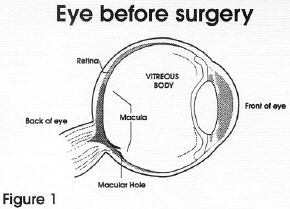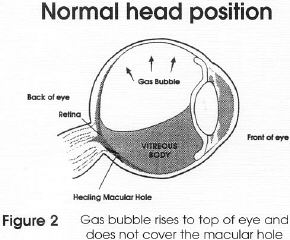
|
The macula is the small part of the retina responsible for central vision. A tear or hole in the macula impairs ones ability to see. Many activities, including reading and writing may become nearly impossible. This condition, most prevalent among the elderly, arises when the vitreous (the jelly-like substance which fills the inner eye) becomes condensed and fibrous. The fibers often bond to the macula, and when they shrink they exert a pulling force. A hole is opened (see Figure 1), and the surrounding tissue peels away from the eye, causing a loss of central vision. To repair the macular hole, the surgeon removes the vitreous and replaces it with a gas bubble (see Figure 2). The bubble rises and applies pressure to the area in need of the healing. Since the macula is at the back of the eye, the gas bubble will only work if the patient's head is positioned face-down. Pressure against the hole flattens the macula against the wall of the eye (see Figure 3), and the impaired visual area is minimized. During the ensuing weeks, the afflicted eye will begin to heal, the macula will re-bond to the eye wall, and a new vitreous replaces the gas bubble. Macular hole/Vitrectomy surgery is a easy, painless procedure with a successful track record of improving or virtually restoring vision. The real challenge for the patient is dealing with the monotony, stress, and discomfort of maintaining the face-down position on a continuous basis for several weeks. More information can be found on the National Eye Institute website: click here |

|
|

|
|